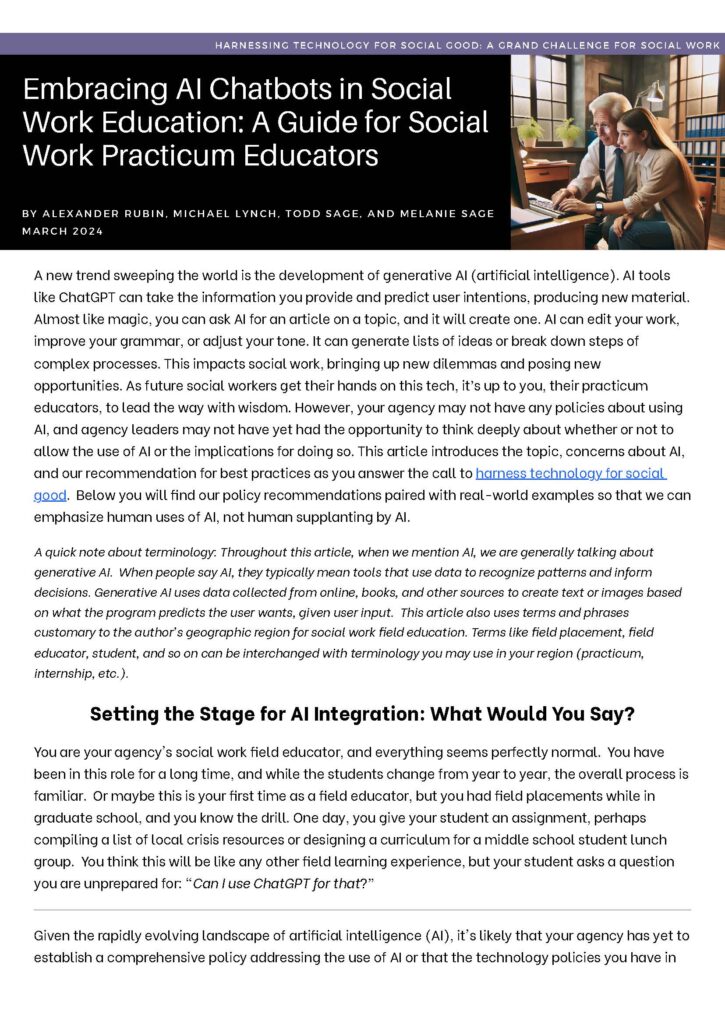Navigating AI in Social Work Education
Editor’s note: In this blog post, four social worker educators share a sample from their new and free resource about using Artificial Intelligence (AI) in social work education. Alexander Rubin, LCSW, is a clinical assistant professor based in field education at the University at Buffalo School of School of Social Work. He specializes in community partnership development, field-specific teaching, and innovation in field education. Michael Lynch, LMSW, is a clinical associate professor at the University at Buffalo School of Social Work. He specializes in experiential learning, community partnerships, and the use of technology in social work practice and education. Todd Sage, Ph.D., MSW, is a clinical associate professor at the University at Buffalo School of Social Work. He is the chemical dependency track coordinator and mental health track chair. He researches technology and child welfare and enjoys integrating emerging technologies in the classroom and as a field instructor. Melanie Sage, Ph.D., LCSW, is a tech consultant for universities, social work departments, and social work agencies. She is an expert in generative AI, machine learning in social work, social media use, online education, and teaching with technology. She also works with agencies to train staff in Motivational Interviewing.
As social work educators, we find ourselves at a point where the capabilities of generative artificial intelligence (AI) tools like ChatGPT intersect with our professional practice more and more often, and we ponder these challenges with much philosophical debate in academic settings. But we send our students out to their practicum sites, and the debates are no longer philosophical; real-life decisions affect agencies, students, and clients, and these challenges must be thoughtfully and practically addressed. The emergence of AI has outpaced the development of comprehensive policy in numerous professional settings. This is why we wrote an article to offer guidance and considerations for the social work field educator with a student placed in their agency. Our goal is to introduce use cases, debates, and potential policies. The full article can be downloaded here and shared with your local social services agencies.
Using Artificial Intelligence in Social Work Field Education
Editor’s Note: Jacqueline Jones is the MSW Field Coordinator at the University of Alabama at Birmingham and one of my colleagues in the UAB Department of Social Work. She has over six years of experience supervising students during field placements and eight years of social work practice experience. In this blog post, she shares how she uses artificial intelligence tools to improve her teaching and save time.
I think, in many ways, social workers shy away from technology and, seemingly, advanced computer systems. In an ever-evolving world where social media, email, and searching the World Wide Web are literally at our fingertips, I believe social workers should embrace the use of technology in their practice and what it is capable of doing to help not only us but our clients, too.
I will expand on using one specific realm of technology in social work education: artificial intelligence or AI. Currently, I serve as the Masters of Social Work (MSW) Field Coordinator at the University of Alabama at Birmingham, which means teaching seminar courses for field education. This semester, I decided to use AI to assist me in developing in-class activities for my MSW students.
What is AI? Here is the answer that ChatGPT gave me in a matter of seconds to give you a glimpse of what AI can do.
A review of Teaching & Learning in Social Work for 2020
2020 was a strange year with many firsts for me – first global pandemic, first sabbatical, first live sessions in an online course, etc. Because of all these firsts, blogging took a bit of back seat to some of my other projects and goals for the year. I had four goals for the blog over the year, and some minor successes. They were:
#1 – Publish 30 posts – only published 19
#2 – Enhance the reach of the blog – there were almost 45,500 visitors from 153 different countries with each visitor spending an average of 1 minute on the blog.
#3 – Build a culture of engagement – only had 10 comments for the year.
#4 – Publish content in other places – there will be two articles in 2021 with content from the blog.
Outside of these goals, I did update content on the blog and created an archive page. The two most popular blog posts of 2020 were:
A Love Letter to Social Workers on the Front Lines of COVID-19 (4/10/20) by Melanie Sage with over 24,000 visits
The Power of Lighting in a Virtual Classroom: Tips on Improving Webcam Lighting for Online Educators (3/16/20) by Agata Dera with over 3,000 visits
Book Group Discussion Guide for Teaching Social Work with Digital Technology

Back in September, Melanie Sage, Nancy Smyth, and I announced a virtual book group for our work – Teaching Social Work with Digital Technology. The goals of the book group were to: 1) create a supportive learning community; and 2) provide space for reflection about one’s own professional development with teaching with technology. You can read more about this blog post:
Teaching Social Work with Digital Technology Book Group
We launched our book group in January and ended it in June 2020, with monthly meetings and a moderated online private Facebook group. The group included a monthly live virtual meeting with discussion moderated by the authors and guest facilitators. Live meetings allowed members to participate and ask questions. In between these live meetings, the facilitators led and moderated discussions about teaching with tech, offering reflective questions and simple learning tasks. Additionally, all live meetings were recorded and archived for later viewing in the group. We will leave the group up as an archive until the end of 2020. Please know that this group will no longer be moderated.
Overall, we had a total of 223 members in the group, and based on the group analytics there were over two hundred posts submitted, and a lot more members reviewing/reading the posts. Although we expected greater engagement, we know that this year brought unexpected challenges for all of us. We believe that good discussion prompts and questions from our facilitators promoted thoughtful reflection and engagement each month. We are sharing these questions and prompts here in this blog post so that others can use them for their own review or to start book groups in their institutions. Here is the discussion guide:
Virtual Field Education: Harnessing Technology and Campus Partnerships to Provide Learning Opportunities

Editor’s Note: In this blog post, Michael Lynch, Clinical Assistant Professor of Field Education at the University at Buffalo’s School of Social Work, shares how his field program shifted their curriculum from in-person, place-based learning activities to remote learning during the national quarantine from the COVID19 pandemic in March 2020. Specifically, he talks about how social work field programs can leverage partnerships and opportunities within their own institution to quickly meet the educational needs of field students. You can connect with Michael at mrlynch2@buffalo.edu
With the intensification of the global pandemic in March 2020, most higher education programs in the United States quickly switched all of their courses to a distance-learning model. This disruption has forced social work instructors to think creatively about how to deliver content and experiences in new ways. For social work field education programs, this transition poses additional difficulty due to its client-facing, experiential nature. For example, students in field education typically are intervening directly with clients in settings like schools, mental health clinics, prisons, and hospitals. Students provide counseling, mentorship, and other forms of support directly to clients in an in-person environment.
Tech-based Assignments for Remote Teaching & Learning in Social Work
In social work education, we are all trying to figure out how to transition our students, instructors, field supervisors, and courses to remote learning (AKA online course delivery). This is no small feat given that COVID-19 has affected all of us personally as well as professionally. Myself, I have been working to create remote volunteering options for over 100 BSW students in three service learning courses (more on that later).
Over the past few years, I have written about different types of technology-based assignments on this blog, and have asked several other social work educators to share their technology-based learning activities and experiences. In this post, I am pulling together a list of technology-based assignments that you can use and adapt for your own needs during these strange times.




